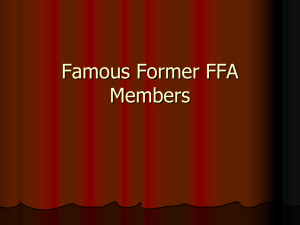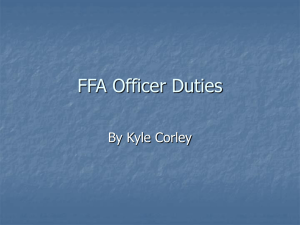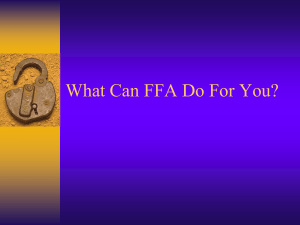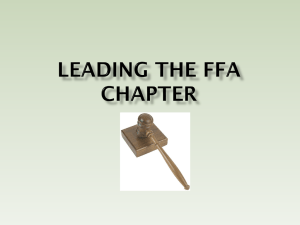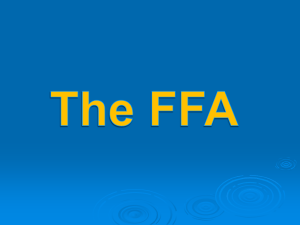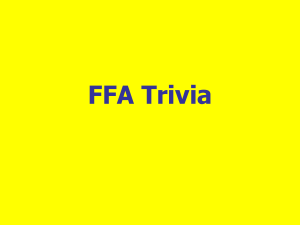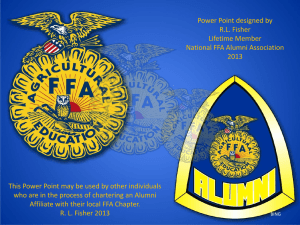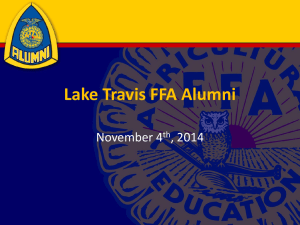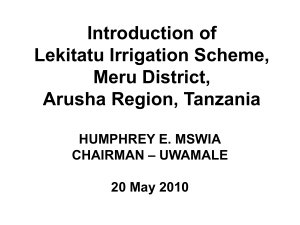- Center
advertisement
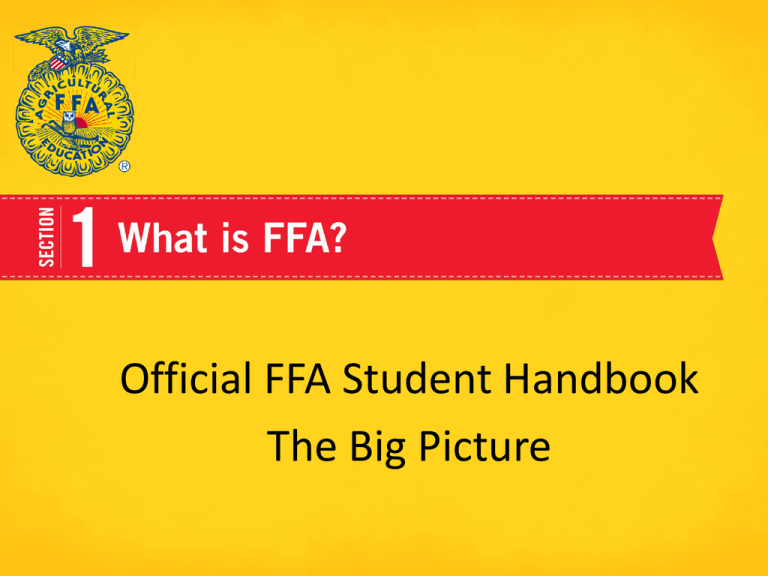
Official FFA Student Handbook The Big Picture Three Circle Model • Instruction • FFA • Supervised Agricultural Experience Three Circle Model • Instruction: – Can look forward to an exciting and fun experience as you explore agriculture. – Classroom & Laboratory work. – Big Difference: Hands on work experience. – Fun! • FFA: Three Circle Model – When enrolled in Agriculture Education you are eligible to join FFA. – Nations LARGEST student organization. – Traveling opportunities. – Meet new people. – Fun! Three Circle Model • Supervised Agricultural Experience : – In agriculture education you start an SAE program – Based on an agriculture related job. – Can earn awards & money! FFA Mission FFA makes a positive difference in the lives of students by developing their potential for premier leadership, personal growth and career success through agricultural education. FFA Premier Leadership Personal Growth Career Success Three Pillars of the FFA Mission FFA Precepts Premier Leadership Personal Growth Career Success Action Physical Growth Communications Relationships Social Growth Decision Making Vision Professional Growth Flexibility/Adaptability Character Mental Growth Technical/Function Skills in Agriculture Awareness Emotional Growth Continuous Improvement Spiritual Growth FFA Motto “Learning to Do, Doing to Learn, Earning to Live, Living to Serve.” 12 powerful words What’s in it for me? • Activity: – Each student will choose a blue heading on page 4 & 5. – Read the section you choose. – Once you have read your section, write down an explanation to your parents about why you should join the FFA using what you learned in your designated section. – Be convincing! Opportunities in FFA • • • • • • • • Lead Travel Earn Money Be Part of the Team Civic Engagement Succeed Make Positive Choices Have Fun FFA History Milestones • 1917 - Smith-Hughes Vocational Education Act – Provided federal funds to high schools that had vocational education classes. – Organizations like Future Farmers of Virginia began to form Milestones • 1928 – National Organization of the Future Farmers of America was formed – 18 states were represented – 33 official delegates – Dues: 10 cents/member/year First Leaders • Dr. Charles Homer Lane, First National FFA Advisor • Henry C. Groseclose, First National FFA Executive Secretary and Treasurer • Harry Oscar Sampson, Founder of the Young Farmers Organization of New Jersey • Harvey Owen Sargent, Co-Founder of New Farmers of America • G.W. Owens, Co-Founder of New Farmers of America • J.R. Thomas, National NFA Advisor • David Simmons, First National NFA President FFA CREED By Erwin Milton “E.M.” Tiffany I believe in the future of agriculture, with a faith born not of words but of deeds - achievements won by the present and past generations of agriculturists; in the promise of better days through better ways, even as the better things we now enjoy have come to us from the struggles of former years. I believe that to live and work on a good farm, or to be engaged in other agricultural pursuits, is pleasant as well as challenging; for I know the joys and discomforts of agricultural life and hold an inborn fondness for those associations which, even in hours of discouragement, I cannot deny. I believe in leadership from ourselves and respect from others. I believe in my own ability to work efficiently and think clearly, with such knowledge and skill as I can secure, and in the ability of progressive agriculturists to serve our own and the public interest in producing and marketing the product of our toil. I believe in less dependence on begging and more power in bargaining; in the life abundant and enough honest wealth to help make it so--for others as well as myself; in less need for charity and more of it when needed; in being happy myself and playing square with those whose happiness depends upon me. I believe that American agriculture can and will hold true to the best traditions of our national life and that I can exert an influence in my home and community which will stand solid for my part in that inspiring task. FFA Creed Paragraphs 1 and 2 I believe in the future of agriculture, with a faith born not of words but of deeds - achievements won by the present and past generations of agriculturists; in the promise of better days through better ways, even as the better things we now enjoy have come to us from the struggles of former years. I believe that to live and work on a good farm, or to be engaged in other agricultural pursuits, is pleasant as well as challenging; for I know the joys and discomforts of agricultural life and hold an inborn fondness for those associations which, even in hours of discouragement, I cannot deny. FFA Creed Paragraphs 3, 4 and 5 I believe in leadership from ourselves and respect from others. I believe in my own ability to work efficiently and think clearly, with such knowledge and skill as I can secure, and in the ability of progressive agriculturists to serve our own and the public interest in producing and marketing the product of our toil. I believe in less dependence on begging and more power in bargaining; in the life abundant and enough honest wealth to help make it so--for others as well as myself; in less need for charity and more of it when needed; in being happy myself and playing square with those whose happiness depends upon me. I believe that American agriculture can and will hold true to the best traditions of our national life and that I can exert an influence in my home and community which will stand solid for my part in that inspiring task. Only Blue Will Do Significance of the Blue Corduroy Jacket: • The most recognizable symbol of the FFA Organization • Allows members to be on an even playing field when participating in various FFA events. • Legacy began in Fredericktown, Ohio • Today more than 66,000 blue corduroy jackets are sold to FFA members each year. Official Dress for Female Members 1. Official FFA jacket, zipped to the top 2. Black skirt: Skirt is to be at least knee length, hemmed evenly across the bottom, with a slit no higher than two inches above the knee, excluding the kick pleat. 3. White collared shirt 4. Official FFA blue scarf 5. Black closed heel and toe dress shoes (no boots, sandals, open-toed shoes or tennis shoes), worn with black nylon hosiery Official Dress for Male Members 1. 2. 3. 4. 5. Official FFA jacket, zipped to the top Black slacks (no jeans) White collared shirt Official FFA tie Black dress shoes (no boots, sandals, open-toed shoes or tennis shoes) worn with black socks New Farmers of America • Started in Virginia in 1927 • Official colors were black and gold • Eblem was similar to the FFA emblem, featuring a boll of cotton instead of a cross section of corn New Farmers of America • 1965 - New Farmers of America merged with Future Farmers of America New Farmers of America Creed I believe in the dignity of farm work and that I shall prosper in proportion as I learn to put knowledge and skill into the occupation of farming. I believe that the farm boy who learns to produce better crops and better livestock; who learns to improve and beautify his home surroundings will find joy and success in meeting the challenging situations as they arise in his daily living. I believe that rural organizations should develop their leaders from within; that the boys in the rural communities should look forward to positions of leadership in the civic, social and public life surrounding them. I believe that the life of service is the life that counts; that happiness endures to mankind when it comes from having helped lift the burdens of others. I believe in the practice of cooperation in agriculture; that it will aid in bringing to the man lowest down a wealth of giving as well as receiving. I believe that each farm boy bears the responsibility for finding and developing his talents to the end that the life of his people may thereby be enriched so that happiness and contentment will come to all. Women Join FFA • In 1969 FFA opened membership to females • 1976 first female to hold a national office, Julie Smiley from Washington Women Join FFA • Now females hold more than half of the leadership positions with in FFA chapters. Name Change • As members’ needs changed and evolved with time, the Future Farmers of America adopted many new programs and activities to meet those needs. • By the early 1980s, the Future Farmers of America was recognized as more than an organization for rural farm students. • In 1988, the delegates at the 60th National FFA Convention voted to change the official name of the organization from Future Farmers of America to the National FFA Organization to reflect the changing demographics of its membership. – These changes illustrated an increased emphasis in the business, science and technology of agriculture in addition to production farming and ranching. Convention Locations • The first national FFA convention was held in 1928 in Kansas City, Mo. • After 71 years in Kansas City, the national FFA convention moved to Louisville, Ky., in 1999 for the 72nd annual convention. The national convention remained in Louisville until 2005. • In 2006, the 79th National FFA Convention was held in Indianapolis. • In 2013 the convention will being to rotate between Louisville and Indianapolis every 3 years. Convention Locations • 1928 - 1998 Kansas City, Mo. • 1999 – 2005 Louisville, Ky. • 2006 – 2013 Indianapolis FFA Emblem What’s a logo? • A symbol or other small design adopted by an organization to identify its products, uniform, vehicles, etc. How well do you know your logos?! • Activity: – Break up into teams – A logo will pop up onto the screen, it is your teams job to write down who that logo belongs to. – Make sure you are quiet so the other team doesn’t hear you! – 10 questions. Logo #1 Logo #2 Logo #3 Logo #4 Logo #5 Logo #6 Logo #7 Logo #8 Logo #9 Logo #10 How did you do? • Review each logo How does a logo help a company? • A logo provides a quick first impression of your company, products and/or services. A professionally developed and designed logo helps your customers retain a positive image of your company's quality, reliability, value and more. The FFA Emblem • Cross section of corn represents ‘Unity’: Whether you live in Alaska, Puerto Rico, Maine, Hawaii or one of the states in between, corn is grown somewhere in your state. This agriculture crop signifies unity, and, from the first Thanksgiving feast on, corn has historically served as the foundation crop of American agriculture. It is appropriate then that the cross section of corn be used as the foundation of the national FFA emblem. The FFA Emblem • Rising sun signifies ‘Progress’: Just as the industry of agriculture has developed new technologies and evolved to meet the next generation of consumer demands, the National FFA Organization has continued to evolve as well and continually looks to the future to meet each member’s needs. The rising sun signifies progress and holds the promise that tomorrow will bring a new day, shining with opportunity. The FFA Emblem • Plow signifies ‘Labor and Tillage of the Soil’: The National FFA Organization is an organization founded in agriculture, the backbone of our country. The plow signifies labor and tillage of the soil and the historic foundation of our country’s strength. The FFA Emblem • Eagle symbolizes ‘Freedom’: The eagle is a national symbol which reminds all FFA members of our freedom and the ability to explore new horizons for the future of agriculture. The FFA Emblem • Owl represents ‘Knowledge’: Long recognized as a symbol of wisdom and knowledge, the owl symbolizes the knowledge required to be successful in the industry of agriculture. The FFA Emblem • Agricultural Education and FFA: The words Agricultural Education and FFA are emblazoned in the center of the emblem to signify the combination of learning and leadership necessary for progressive agriculture. FFA Emblem Project • Cut out the pieces of the FFA Emblem and piece them together where they belong. • Place the finished emblem on a piece of poster board provided by Miss F. • Label each piece: What it represents and its meaning.
